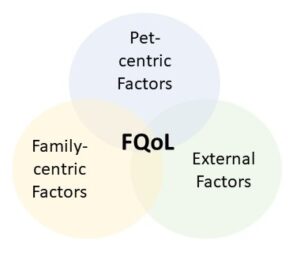As more people include pets as part of their chosen families, it behooves pet professionals to consider the dynamic interaction between the pet’s needs, other family members’ needs, and family-level needs as each of these may be factors in whether, for example, a pet parent follows through with a training plan you’ve given them or whether a family chooses to proceed with a preferred treatment recommendation by a vet. The better we can understand the different factors at play in the broader family system, the higher likelihood that our communication will be effective.
The term “family quality of life” or FQoL has been more commonly used when considering families with human members with special needs. It’s defined as a sense of well-being perceived by its members through the interaction of individual and family-level needs (Smith-Bird & Turnbull, 2005; Zuna et al., 2010).
Brown et al (2023) proposed 3 interrelated domains to be considered as one thinks about FQoL with pet parents and care decisions.

Pet-centric factors include the pet’s medical condition, mental health, behavior, and quality of life. Family-centric factors include the family’s resources, culture, values, history, and how decisions will affect individuals, other pets, and the family as a unit. Lastly, external factors includes things such as housing restrictions, social support, and animal control regulations.
In episode #46 of our podcast, Dr. Micaela Young shared that one of the things she’d like to see improved in the field is more effective team building among the various people who intersect within the life of your pet. A critical component of team building is effective communication. Often we, and by that I mean, pet professionals and pet parents, may make assumptions about things which may not be accurate. Thinking about FQoL and the complex interplay between the different domains can help elucidate possible areas where questions can be asked and information shared to improve communication between parties. For example, I may recommend to a pet parent with a fearful dog who struggles on walks in a neighborhood where it’s difficult to avoid triggers that they take a break from those walks. Perhaps time is short so I don’t provide an adequate explanation of why I’m making this recommendation nor do I ask any follow up questions about feasibility or concerns about this recommendation. Lo and behold I find out in our next session that the neighborhood walks continued despite my recommendation. My recommendation focused on this dog’s well-being (pet-centric factor) and I ignored how this may interplay possibly with family-centric factors or external factors.
Effective communication is a two-way street. In this example, I could have provided an explanation for my recommendation as well as asked follow-up questions to ascertain possible barriers. At the same time, I would hope that a pet parent I am working with will feel comfortable to ‘get curious’ and ask questions (“Why are you recommending this?”) as well as share relevant FQoL information (“It’s going to be hard for me to let go of our daily walks because I get a lot out of them” or “I’m worried if I don’t walk Sadie that she will get more stirred up in our apartment and make a lot of noise; we’ve already had neighbors complain about barking.”). Having greater understanding of these FQoL issues will help us be more effective as a team working together.
For many, pets are part of our chosen family. Actions taken or decisions made to improve the well-being of pets intersect with other factors within the family system. The more that pet parents and pet professionals are aware of these domains and can openly discuss with one another these FQoL factors, the greater likelihood for effective communication with fewer assumptions and perhaps less of the emotions that can get attached to assumptions like ill-will, wrongdoing, or guilt.
Now what?
- Consider the three domains of FQoL and how they may have influenced a recent or current decision or action that you’ve taken on behalf of your pet.
- Given the three domains of FQoL, what might be 1 piece of information that would be useful to share with your pet professional that helps facilitate a greater understanding of your family’s context to more effectively work together?
Happy Training,
Tracy
References
Brown, C.R., Edwards, S., Kenney, E., Pailler, S., Albino, M., Carabello, M., Good, K., & Lopez, J. (2023). Family Quality of Life: pet owners and veterinarians working together to reach the best outcomes. Journal of the American Veterinary Medical Association.
https://avmajournals.avma.org/view/journals/javma/aop/javma.23.01.0016/javma.23.01.0016.xml
Smith-Bird, E., & Turnbull, A.P. (2005). Linking positive behavior support to family quality-of-life outcomes. J. Positive Behavior Interventions, 7, 174–180.
Zuna, N. I., Brown, I., & Brown, R. I. (2014). Family quality of life in intellectual and developmental disabilities: A support-based framework to enhance quality of life in other families. In R. I. Brown & R. M. Faragher (Eds.), Quality of life and intellectual disability: Knowledge application to other social and educational challenges (pp. 91–119). Nova Science Publishers.

